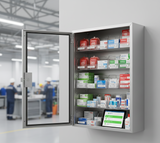Beyond the Backache: A Business Guide to Workplace Ergonomics
When you think of workplace safety, your mind might immediately jump to hard hats, safety glasses, or fire extinguishers. And while those are undeniably crucial, there's a silent, pervasive hazard that impacts countless employees across every industry, from the office desk to the factory floor: poor ergonomics.
Ergonomics is the science of designing the workplace to fit the worker, rather than forcing the worker to fit the workplace. Ignoring it doesn't just lead to a few complaints; it can result in serious, long-term injuries, decreased productivity, and significant costs for your business.
At Your Safety Company, we understand that true workplace safety means creating an environment where employees are comfortable, efficient, and free from preventable strain. Let's delve into why ergonomics is more than just about avoiding a backache – it's about smart business.
The Hidden Impact of Poor Ergonomics
Musculoskeletal Injuries (MSIs), often referred to as cumulative trauma disorders or repetitive strain injuries (RSIs), are among the most common and costly workplace injuries. These include:
-
Back pain: From prolonged sitting, improper lifting, or awkward postures.
-
Carpal Tunnel Syndrome: Affecting wrists and hands due to repetitive movements and poor workstation setup.
-
Tendonitis: Inflammation of tendons, often in shoulders, elbows, or wrists.
-
Neck and shoulder strain: From extended computer use or overhead work.
These injuries don't just cause employee discomfort; they lead to:
-
Increased Workers' Compensation Claims: Direct costs that hit your bottom line.
-
Lost Productivity & Absenteeism: Injured employees may need time off or work at reduced capacity.
-
Higher Turnover: Employees might seek jobs with better working conditions.
-
Reduced Morale: A workforce experiencing pain and discomfort is a less happy and less engaged workforce.
-
Training Costs: For temporary or new hires replacing injured workers.
The Pillars of a Proactive Ergonomics Program
Implementing an effective ergonomics program doesn't have to be a daunting overhaul. It starts with awareness and a systematic approach.
-
Assess Your Workplace for Ergonomic Risks:
-
Observe Tasks: Watch employees performing their duties. Are they twisting, reaching excessively, bending awkwardly, or performing repetitive motions for long periods?
-
Gather Feedback: Talk to your employees. They are often the best source of information about discomfort or difficulty performing tasks.
-
Review Injury Records: Look for patterns in reported MSIs. This can highlight problem areas.
-
-
Apply Ergonomic Principles to Job Design:
-
Minimize Repetitive Motions: Can tasks be rotated? Can automation assist?
-
Reduce Forceful Exertions: Can tools assist with heavy lifting or gripping?
-
Optimize Posture: Ensure work surfaces, chairs, and equipment are adjustable to promote neutral postures.
-
Provide Adequate Rest & Stretch Breaks: Encourage micro-breaks to relieve static loads.
-
-
Invest in Ergonomic Solutions & Equipment:
-
Adjustable Workstations: Desks, chairs, and monitors that can be customized to the individual worker.
-
Ergonomic Tools: Tools designed to fit the hand better and reduce strain.
-
Anti-Fatigue Mats: Essential for employees who stand for long periods.
-
Lifting Aids: Carts, hoists, and dollies to reduce manual handling strain.
-
Specialized PPE: Certain gloves can reduce vibration or improve grip, easing strain.
-
-
Train Your Employees:
-
Educate employees on proper lifting techniques, workstation setup, and the importance of taking breaks.
-
Empower them to report discomfort or suggest ergonomic improvements.
-
Beyond the Quick Fix: Building a Culture of Comfort & Safety
Ergonomics isn't a one-time fix; it's an ongoing commitment. By proactively addressing ergonomic risks, you're not just preventing injuries; you're investing in:
-
Increased Employee Comfort & Morale: A comfortable employee is a happier, more engaged employee.
-
Enhanced Productivity: When workers are free from pain, they can focus better and work more efficiently.
-
Reduced Costs: Less absenteeism, fewer workers' comp claims, and lower training costs.
-
Improved Quality: Comfortable workers make fewer mistakes.
A Healthier, More Productive Workplace
At Your Safety Company, we believe a safe workplace is a productive workplace. While we provide essential PPE, first aid, and emergency solutions, we also understand the broader spectrum of workplace well-being. By considering ergonomic solutions and best practices, you can create an environment where your employees thrive.
Recent Posts
-
Beyond the Big Box: Why Yoursafetycompany.com is the Smarter Choice for Your First-Aid Program
When it comes to workplace first aid, ensuring your business is compliant and your employees are pro …1st Jan 2026 -
The 2026 Safety Checklist: Is Your Crew Truly Protected?
As we move into the new year, it’s the perfect time to look past the daily grind and evaluate the ge …23rd Dec 2025 -
Beyond the Buzz: Why Proper Hearing Protection is Non-Negotiable on Your Job Site
On any given workday, the sounds of progress—drills, saws, heavy machinery, and even loud conversati …22nd Dec 2025



